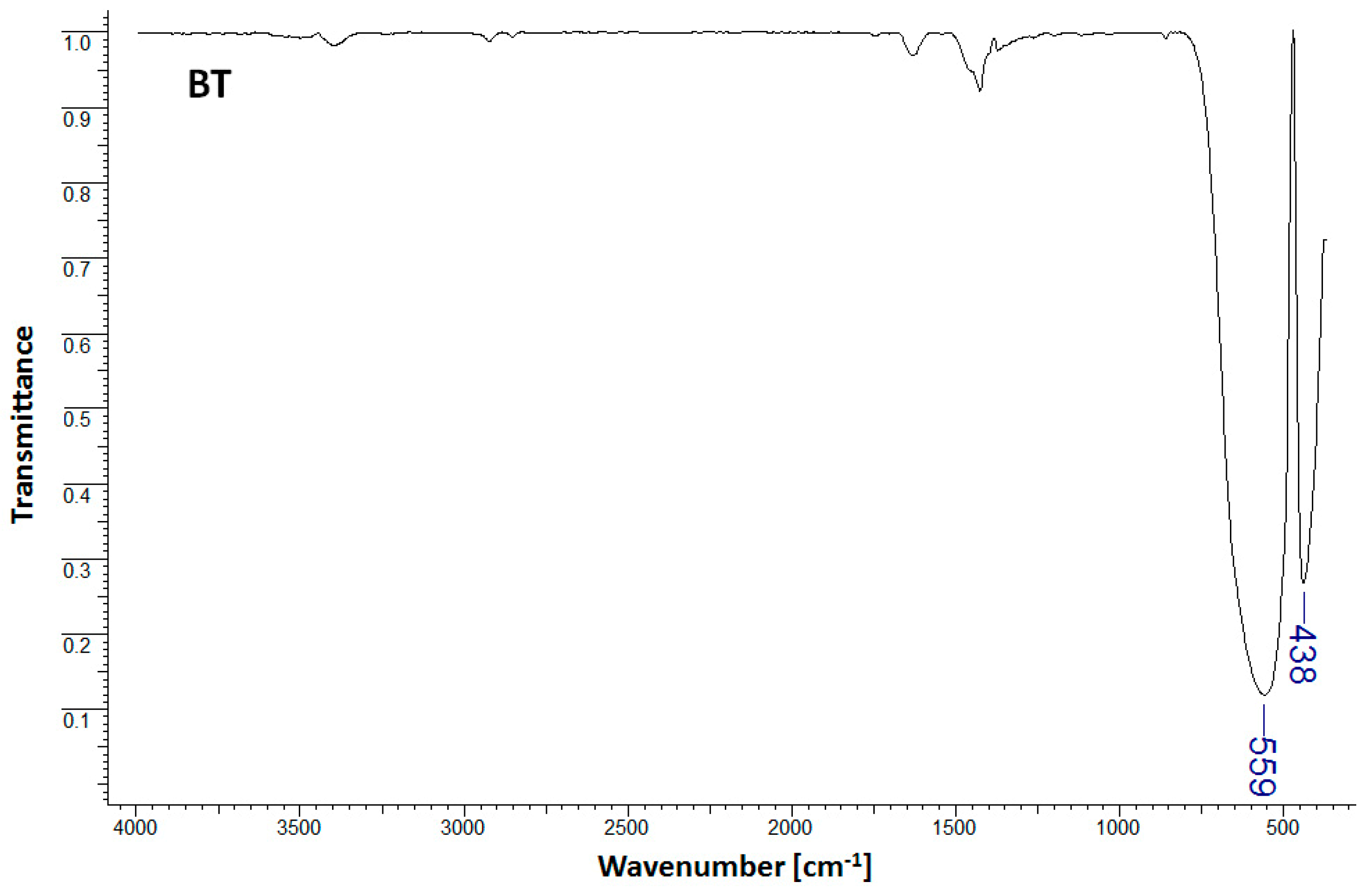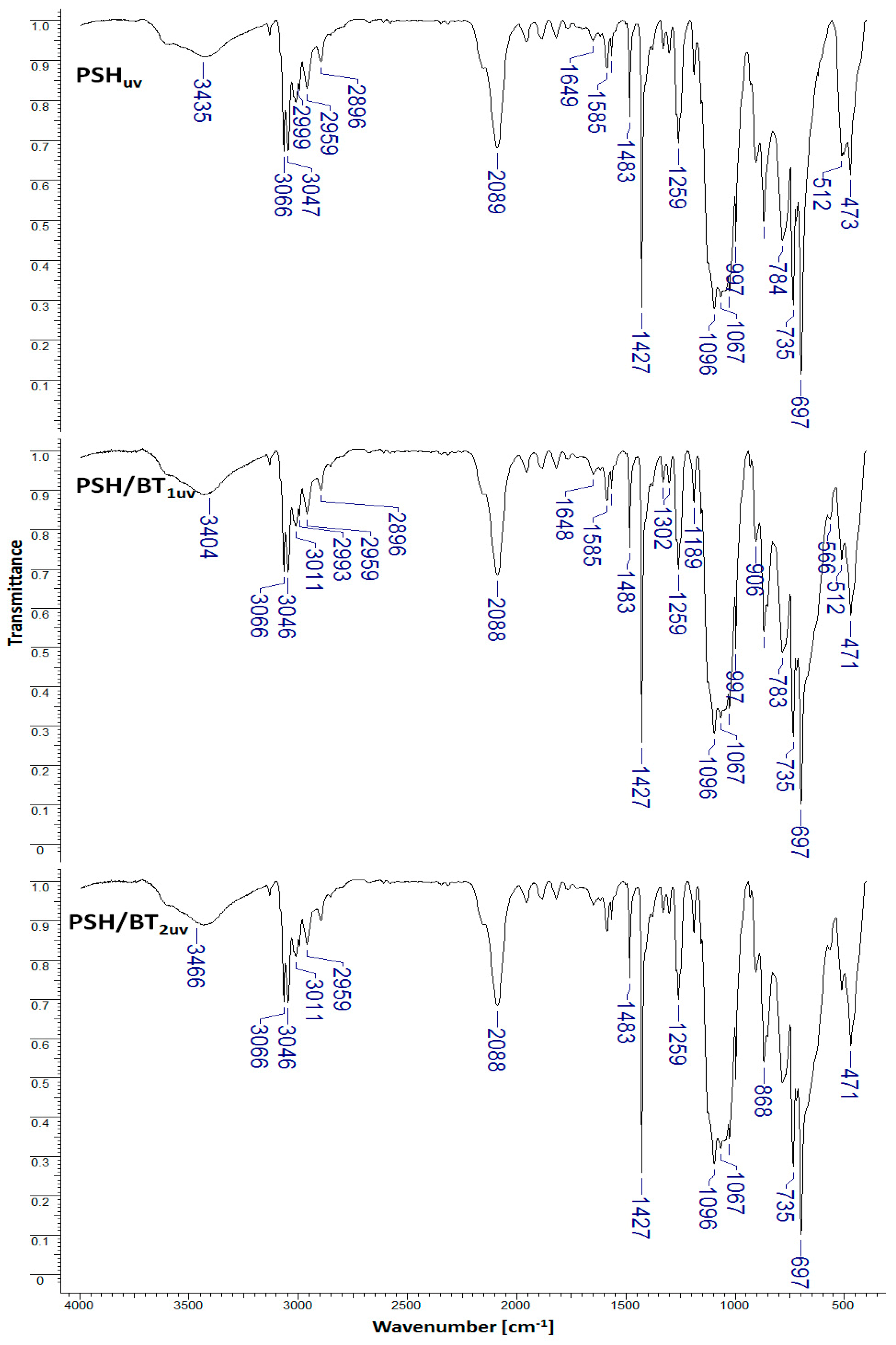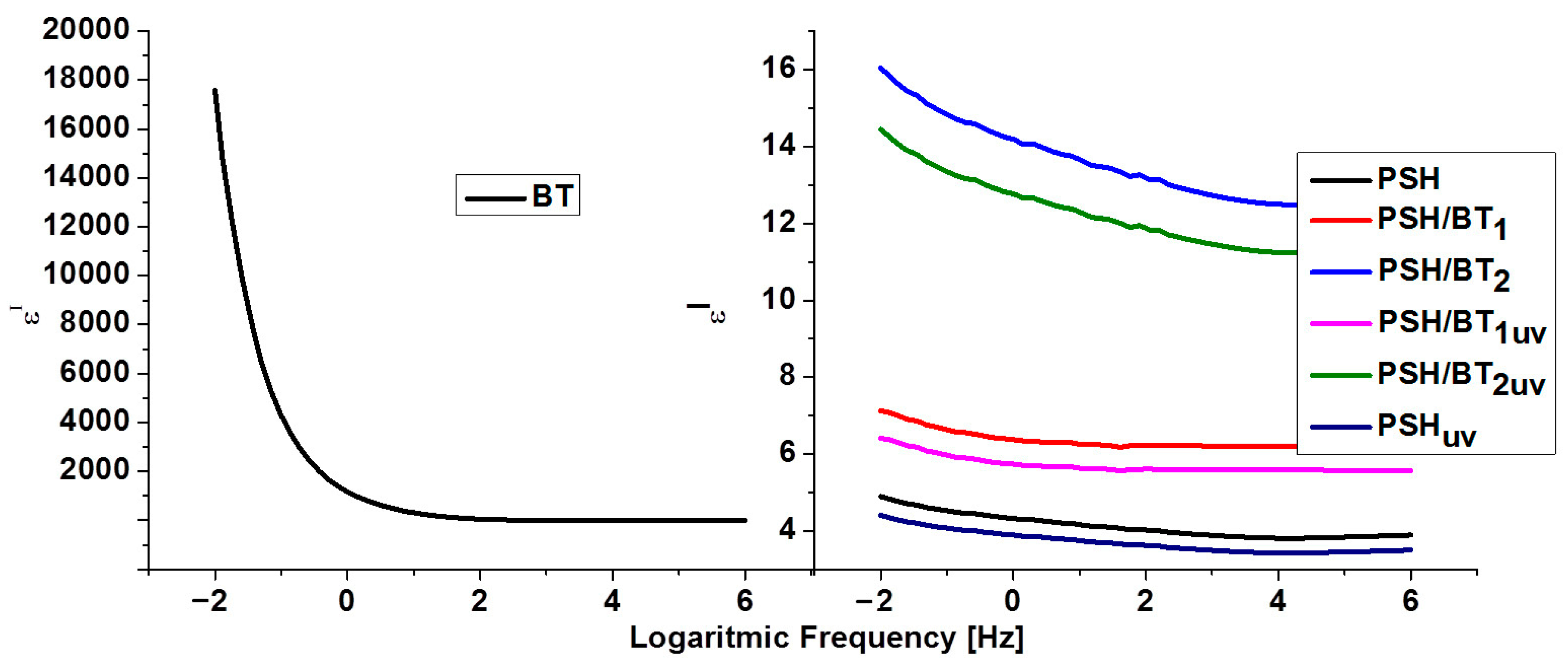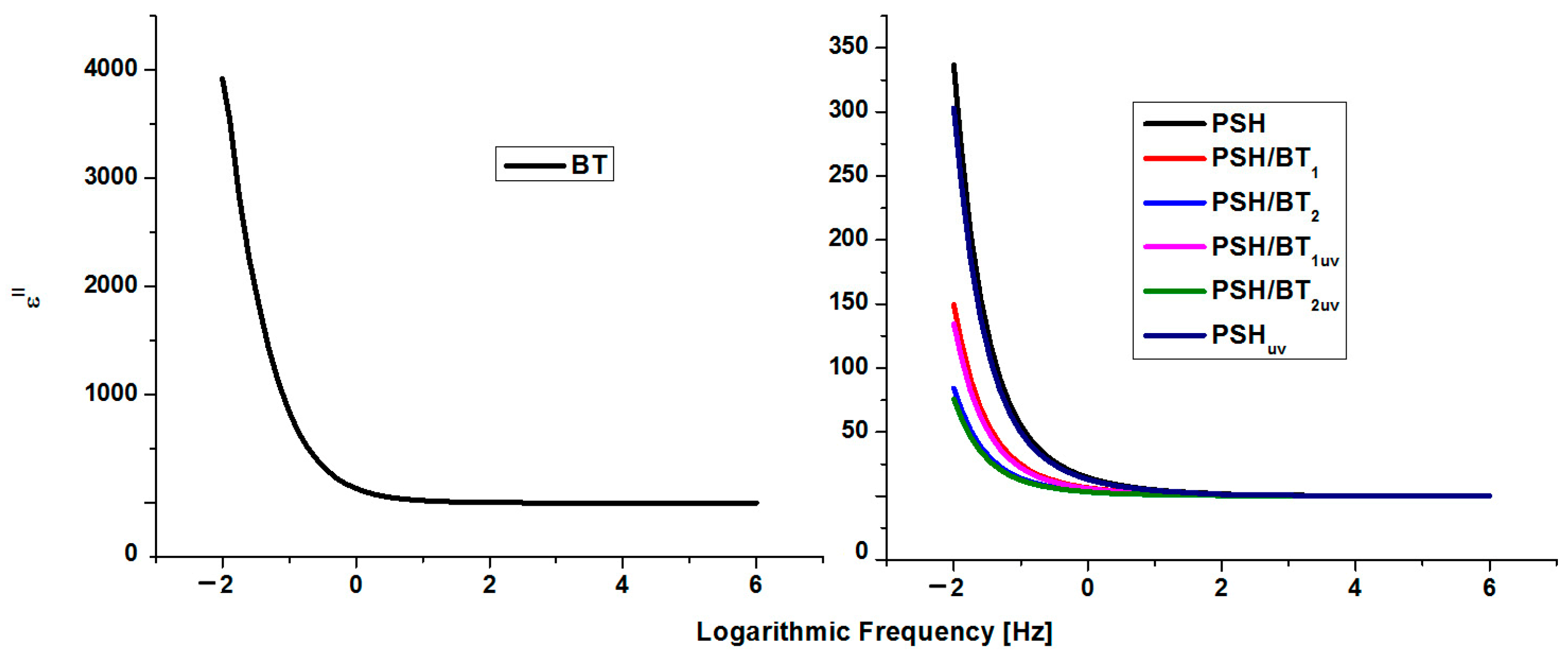Polysilane–Barium Titanate Polymeric Composite Obtained through Ultrasonication
Abstract
:1. Introduction
2. Results and Discussion
2.1. Fourier-Transform Infrared (FTIR) Spectroscopy
2.2. The UV/VIS Absorption Study in the Solid State
3. Materials and Methods
3.1. Materials
3.2. Methods
3.2.1. Barium Titanate (BT) Particle Preparation
3.2.2. Poly(diphenyl-co-methyl(hydrogen))silane (PSH) Preparation
3.2.3. PSH/BT Composite Preparation
4. Conclusions
Author Contributions
Funding
Data Availability Statement
Conflicts of Interest
References
- Nowacki, B.; Mistewicz, K.; Hajra, S.; Kim, H.J. 3D printed triboelectric nanogenerator for underwater ultrasonic sensing. Ultrasonics 2023, 133, 107045. [Google Scholar] [CrossRef] [PubMed]
- Markovic, S.; Mitric, M.; Starcevic, G.; Uskokovic, D. Ultrasonic de-Agglomeration of Barium Titanate Powder. Ultrason. Sonochem. 2008, 15, 16–20. [Google Scholar] [CrossRef] [PubMed]
- Patsidis, A.C. Barium titanate/polydimethylsiloxane nano/microcomposites fabrication, morphology, dielectric response and functionality. IET Nanodielectr. 2020, 1, 14–19. [Google Scholar] [CrossRef]
- Yajima, S.; Hayashi, J.; Okamura, K. Pyrolysis of a polyborodiphenylsiloxane. Nature 1977, 266, 521. [Google Scholar] [CrossRef]
- Miller, R.D.; Michl, J. Poly(di-n-hexyl-silane) in solid solutions: Experimental and theoretical studies of electronic excitations of a disordered linear chain. Chem. Rev. 1989, 89, 1359. [Google Scholar] [CrossRef]
- Nespurek, S.; Pospisil, J.; Kratochvilova, I.; Sworakowski, J. Polymeric Composites Based on Polysilanes for Plastic Electronics. Mol. Cryst. Liq. Cryst. 2008, 484, 265–631. [Google Scholar] [CrossRef]
- Feigl, A.; Bockholt, A.; Weis, J.; Rieger, B. Modern Synthetic and Application Aspects of Polysilanes: An Underestimated Class of Materials? In Silicon Polymers: Advances in Polymer Science; Muzafarov, A.M., Ed.; Springer: Berlin/Heidelberg, Germany, 2009; Volume 235, pp. 1–31. [Google Scholar]
- Kumar, V.B.; Leitao, E.M. Properties and applications of polysilanes. Appl. Organomet. Chem. 2020, 34, e5402. [Google Scholar] [CrossRef]
- Qin, M.; Zhang, L.; Wu, H. Dielectric loss mechanism in electromagnetic wave absorbing materials. Adv. Sci. 2022, 9, 105553. [Google Scholar] [CrossRef] [PubMed]
- Sundar, U.; Lao, Z.; Cook-Chennault, K. Enhanced Dielectric Permittivity of Optimized Surface Modified of Barium Titanate Nanocomposites. Polymers 2020, 12, 827. [Google Scholar] [CrossRef]
- Fortună, M.E.; Ignat, M.; Tudorachi, N.; Ungureanu, E.; Rotaru, R.; Harabagiu, V. Hybrid Siloxane Materials Based on a Mutually Reactive Epoxy–Amine System: Synthesis, Structure, and Thermal Stability Investigations. Inorganics 2024, 4, 118. [Google Scholar] [CrossRef]
- Um, M.H.; Lee, C.T.; Kumasawa, H.J. Preparation and dielectric properties of ferroelectric barium titanate fine particles by hydrothermal method. J. Ind. Eng. Chem. 1997, 3, 251–256. [Google Scholar]
- Liu, P.; Hong Ng, V.M.; Yao, Z.; Zhou, J.; Lei, Y.; Yang, Z.; Lv, H.; Kong, L.B. Facile synthesis and hierarchical assembly of flowerlike NiO structures with enhanced dielectric and microwave absorption properties. ACS Appl. Mater. Interfaces 2017, 9, 16404–16416. [Google Scholar] [CrossRef]
- Liu, G.H.; Wei, C.Y.; Huang, T.; Wang, F.; Chang, J.F.; Sun, Q.; Zhang, X.H. Metal-catalyzed carbon foams synthesized from glucose as highly efficient electromagnetic absorbers. Materials 2024, 17, 3488. [Google Scholar] [CrossRef] [PubMed]
- Miller, R.D.; Wallraff, G.; Clecak, N.; Sooriyakumaran, R.; Michl, J.; Karatsu, T.; McKinle, A.J.; Klingensmith, K.A.; Downing, J. Polysilanes: Solution Photochemistry and Deep-UV Lithography. Polym. Eng. Sci. 1989, 29, 882–886. [Google Scholar] [CrossRef]
- Rotaru, R.; Popescu, C.M.; Dascalu, A.; Timpu, D.; Asanduleasa, M.; Fortuna, M.E.; Harabagiu, V. Influence of Ultrasonic Treatment and Heating/Cooling Under Electric Field on High-K Cellulose-Barium Titanate Composites. Rev. Roum. Chim. 2023, 68, 175–185. [Google Scholar] [CrossRef]
- Astapenko, V. Polarization Bremsstrahlung on Atoms, Plasmas, Nanostructures and Solids, Chapter Polarization Bremsstrahlung on Nanostructures; Springer: Berlin/Heidelberg, Germany, 2013; pp. 207–243. ISBN 978-3-642-34082-6. [Google Scholar]
- Devan, R.S.; Chougule, B.K. Effect of composition on coupled electric, magnetic, and dielectric properties of two phase particulate magnetoelectric composite. J. Appl. Phys. 2007, 101, 014109. [Google Scholar] [CrossRef]
- Lines, M.E.; Glass, A.M. The Ferroelectric Perovskites—Barium Titanate. In Principles and Applications of Ferroelectric and Related Materials; Clarendon Press: Oxford, UK, 2001; pp. 241–245. [Google Scholar]
- Paunovic, V.; Mitic, V.V.; Kocic, L. Dielectric characteristic of donor-acceptor modified BaTiO3 ceramics. Ceram. Int. 2016, 42, 11692–11699. [Google Scholar] [CrossRef]
- Mitic, V.V.; Paunovic, V.; Kocic, L. Fractal approach to BaTiO3- ceramics micro-impedances. Ceram. Int. 2015, 41, 6566–6574. [Google Scholar] [CrossRef]
- Wang, Q.; Che, J.; Wu, W.; Hu, Z.; Liu, X.; Ren, T.; Chen, Y.; Zhang, J. Contributing factors of dielectric properties for polymer matrix composites. Polymers 2023, 15, 590. [Google Scholar] [CrossRef]
- Taherian, R. Electrical Conductivity in Polymer-Based Composites: Experiments, Modelling, and Applications; Elsevier: Amsterdam, The Netherlands, 2018. [Google Scholar]
- Sacarescu, L.; Fortuna, M.; Soroceanu, M.; Cojocaru, C.; Sacarescu, G.; Simionescu, M.; Harabagiu, V. Computational Study of the Electronic Absorption Spectra of Polyhydrosilanes. Silicon 2015, 7, 343–349. [Google Scholar] [CrossRef]
- Santos, H.M.; Lodeiro, C.; Capelo-Martinez, J.L. The Power of Ultrasound. In Ultrasound in Chemistry: Analytical Applications; Capelo-Martinez, J.L., Ed.; Wiley-VCH Verlag GmbH & Co., KGaA: Weinheim, Germany, 2008; pp. 1–15. [Google Scholar]
- Shokrollahi, H. A review of the magnetic properties, synthesis methods and applications of maghemite. J. Magn. Magn. Mater. 2017, 426, 74–81. [Google Scholar] [CrossRef]
- Fatimah, I.; Fadillah, G.; Yudha, S.P. Synthesis of iron-based magnetic nanocomposites: A review. Arab. J. Chem. 2024, 17, 105405. [Google Scholar] [CrossRef]
- Ahmed, M.A.; Seddik, U.; Okasha, N.; Imam, N.G. One-dimensional nanoferroic rods; synthesis and characterization. J. Mol. Struct. 2015, 1099, 330–339. [Google Scholar] [CrossRef]








| Relative Ratio/Sample | PSH | PSHUV | PSH/BT1 | PSH/BT1UV | PSH/BT2 | PSH/BT2UV |
|---|---|---|---|---|---|---|
| Si-Si/Si-O-C | 0.78 | 0.36 | 0.74 | 0.69 | 0.76 | 0.74 |
| Si-Si/Si-H | 1.30 | 1.11 | 1.29 | 1.20 | 1.28 | 1.26 |
| Si-Si/Si-CH3 | 1.14 | 1.06 | 1.13 | 1.09 | 1.14 | 1.13 |
| Si-Si/Si-C6H5 | 0.78 | 0.53 | 0.81 | 0.75 | 0.82 | 0.79 |
| Si-H/Si-CH3 | 0.60 | 0.63 | 0.59 | 0.61 | 0.61 | 0.60 |
| Si-H/Si-C6H5 | 0.59 | 0.53 | 0.56 | 0.50 | 0.56 | 0.56 |
| Si-H/Si-O-C | 0.60 | 0.36 | 0.57 | 0.48 | 0.55 | 0.55 |
| Si-CH3/Si-C6H5 | 0.68 | 0.62 | 0.69 | 0.63 | 0.70 | 0.69 |
| Sample | Ratio PSH/BT w/w | Homogenization Time by Ultrasonication [min] | Total Energy Dissipated in the Form of Ultrasonic Waves [kJ] | Temperature at the End of Synthesis [°C] | UV Irradiation (30 min at 365 nm) |
|---|---|---|---|---|---|
| PSH/BT1 | 1/0.1 | 10 | 24.7 | 78 | no |
| PSH/BT2 | 1/0.2 | 10 | 26.4 | 81 | no |
| PSHuv | - | - | - | - | yes |
| PSH/BT1uv | 1/0.1 | 10 | 24.7 | 78 | yes |
| PSH/BT2uv | 1/0.2 | 10 | 26.4 | 81 | yes |
Disclaimer/Publisher’s Note: The statements, opinions and data contained in all publications are solely those of the individual author(s) and contributor(s) and not of MDPI and/or the editor(s). MDPI and/or the editor(s) disclaim responsibility for any injury to people or property resulting from any ideas, methods, instructions or products referred to in the content. |
© 2024 by the authors. Licensee MDPI, Basel, Switzerland. This article is an open access article distributed under the terms and conditions of the Creative Commons Attribution (CC BY) license (https://creativecommons.org/licenses/by/4.0/).
Share and Cite
Rotaru, R.; Fortună, M.E.; Ungureanu, E.; Sacarescu, L. Polysilane–Barium Titanate Polymeric Composite Obtained through Ultrasonication. Inorganics 2024, 12, 213. https://doi.org/10.3390/inorganics12080213
Rotaru R, Fortună ME, Ungureanu E, Sacarescu L. Polysilane–Barium Titanate Polymeric Composite Obtained through Ultrasonication. Inorganics. 2024; 12(8):213. https://doi.org/10.3390/inorganics12080213
Chicago/Turabian StyleRotaru, Răzvan, Maria Emiliana Fortună, Elena Ungureanu, and Liviu Sacarescu. 2024. "Polysilane–Barium Titanate Polymeric Composite Obtained through Ultrasonication" Inorganics 12, no. 8: 213. https://doi.org/10.3390/inorganics12080213











